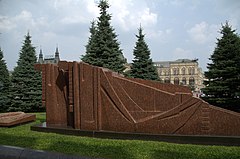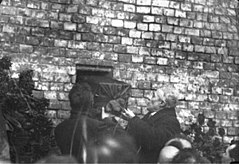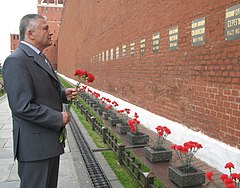Kremlin Wall Necropolis
| Kremlin Wall Necropolis | |
|---|---|
Red Square, Moscow | |
| Country | Soviet Union |
| Coordinates | 55°45′13″N 37°37′11″E / 55.75361°N 37.61972°E |
The Kremlin Wall Necropolis is the former
The Kremlin Wall was the de facto resting place of the Soviet Union's deceased national icons. Burial there was a status symbol among Soviet citizens. The practice of burying dignitaries at Red Square ended with the funeral of General Secretary
Site

The eastern segment of the Kremlin wall, and Red Square behind it, emerged on its present site in the 15th century, during the reign of
Throughout the 18th century the unused, neglected fortifications deteriorated and were not properly repaired until the 1801
| Timeline of burials in Red Square |
|---|
 |
Burials from 1917 to 1927

Between the 1917
| Table: List of burials (by grave) in Red Square ground, 1917–1927[8] | ||||||||||||||||||||||||||||||||
|---|---|---|---|---|---|---|---|---|---|---|---|---|---|---|---|---|---|---|---|---|---|---|---|---|---|---|---|---|---|---|---|---|
|
Mass graves of 1917


In July 1917, hundreds of soldiers of the Russian Northern Front were arrested for mutiny and desertion and locked up in
The following day, loyalists led by Colonel
Voices reached us across the immense place, and the sound of picks and shovels. We crossed over. Mountains of dirt and rock were piled high near the base of the wall. Climbing these we looked down into two massive pits, ten or fifteen feet deep and fifty yards long, where hundreds of soldiers and workers were digging in the light of huge fires. A young student spoke to us in German. "The Brotherhood Grave," he explained.
–Ten Days that Shook the World.[10]
A total of 238 dead were buried in the mass graves between
The loyalists secured a permit to publicly bury their dead on 13 November. This funeral started at the old Moscow State University building near Kremlin; thirty-seven dead were interred at the Vsekhsvyatskoye Cemetery (now demolished) in the then-suburban Sokol District.[14]
Burials of 1918–1927



Mass and individual burials in the ground under the Kremlin wall continued until the funeral of
The largest single burial occurred in 1919. On 25 September,
Another unusual incident was the 24 July 1921 crash of the
| Table: List of burials (by name) in Red Square ground, 1918–1927[12] | ||||||||||||||||||||||
|---|---|---|---|---|---|---|---|---|---|---|---|---|---|---|---|---|---|---|---|---|---|---|
|
Mausoleum, 1924–1961

Vladimir Lenin died of a stroke on 21 January 1924. While his body lay in state in the Pillar Hall of the House of the Unions, the Politburo discussed ways to preserve it, initially for forty days, despite objections from his widow and siblings.[17][18] Joseph Stalin gave instructions to install a vault for Lenin's embalmed remains inside the Kremlin wall, and on 27 January, Lenin's casket was deposited in a temporary wooden vault built in a single day.[17] The first proper Mausoleum was built of wood in March–July 1924 and officially opened on August 1[19] (foreign visitors were allowed inside on August 3).[20][21] The contest to design and build a new, permanent, Mausoleum was announced in April 1926; construction of Alexey Shchusev's winning design began in July 1929 and was completed in sixteen months.[20] The Mausoleum has since functioned as a government reviewing stand during public parades.
The glass sarcophagus of Lenin's tomb was twice vandalized by visitors, in 1959 and 1969, leading to installation of a bulletproof glass shell.[22] It was bombed twice, in 1963, when the terrorist was the sole victim,[22] and in 1973, when an explosion killed the terrorist and two bystanders.[22][23]
The Russian Orthodox Church Outside of Russia has petitioned Russia to dismantle the cult of personality and bury Lenin's body, seeking to "rid Red Square of the remains of the main persecutor and executioner of the 20th century,"[24][25] although the Russian Orthodox Church demurs.[26]
As of 2022, Lenin's body remains in the Mausoleum, excluding the period of evacuation to Tyumen during 1941–1945.[27]
Stalin's mummy
Two days after
Ashes, 1925–1984


The first person to be cremated and interred in an urn in the Kremlin wall, 45-year-old former People's Commissar of Finance Miron Vladimirov, died in Italy in March 1925. The procedure for dealing with human remains in an urn was still unfamiliar at the time, and Vladimirov's urn was carried to his grave in an ordinary coffin.
Between 1925 and the opening of the
Initially, the bodies of the deceased were
Under
- In June 1962, following the death of Army General Andrey Khrulyov, a group of marshals pressed the Politburo to bury Khrulyov in the Kremlin wall. Normally, generals of his rank were not entitled to this honor; Khrushchev was known to dislike Khrulyov and suggested burying him in Novodevichy Cemetery. The military prevailed, and Khrulyov was buried on Red Square.[15]
- In January 1970 the official decision to bury Pavel Belyayev in Novodevichy Cemetery, already made public through newspapers, was confronted by fellow cosmonauts Valentina Tereshkova, Alexei Leonov, and Vladimir Shatalov who insisted that Belyaev deserved a place in the Kremlin wall like Yuri Gagarin. According to Nikolai Kamanin's diaries, the cosmonauts, Shatalov in particular, pressed the issue despite knowing that the decision was made by Brezhnev and Alexei Kosygin and that the funeral commission would not dare to challenge it.[35] Belyaev was buried as planned in Novodevichy. According to an alternative version of events, the choice of Novodevichy was decided by his widow's will before the official decision was published.[36]
- In September 1971, Nikita Khrushchev's family requested that the Soviet government bury Nikita Khrushchev in the Kremlin Wall Necropolis. The Soviet government declined the offer; instead, Nikita Khrushchev was given a private state funeral and buried in Novodevichy Cemetery.
- In December 1971, Andrey Andreyevich Andreyev was buried in Novodevichy Cemetery. According to former Soviet Chairman Anastas Mikoyan, this was because Andrey Andreyev wanted to be buried next to his wife there.
- In July 1989, Andrei Andreyevich Gromyko was offered a grave in the Kremlin Wall Necropolis, but at the request of his family he was not buried near the Moscow Kremlin Wall but instead at the Novodevichy Cemetery.
- In September 2022, leader of the Soviet Union, was buried in Novodevichy Cemetery. Even though Gorbachev was granted approval by Russian presidents Boris Yeltsin and Vladimir Putin to be buried in the Kremlin Wall Necropolis, Gorbachev was buried in Novodevichy Cemetery in the same grave as his wife Raisa, as requested by his will.[37]
On 26 April 1967, cosmonaut Vladimir Komarov, who had died in the crash of his Soyuz 1 space capsule,[38] was given a state funeral in Moscow, and his ashes were interred in the Kremlin Wall Necropolis. Komarov was posthumously awarded the Order of Lenin (for the second time) and the order of Hero of the Soviet Union.
The last person to be buried in the Kremlin wall was Minister of Defence Dmitriy Ustinov in December 1984.
Individual tombs, 1919–1985
The row of individual tombs behind the Mausoleum began to acquire its present shape after the end of
There are, in total, twelve individual tombs; all, including the four burials of the 1980s, are shaped similar to the canonical Merkurov's model. All twelve are considered to have died of natural causes, although some, such as
The Kremlin wall and the stands erected in the 1940s were traditionally separated with a line of blue spruce (
| Table: List of individual tombs on Red Square, 1946–1985[42] | |||||||||||||||||||||||||||||||||||||||
|---|---|---|---|---|---|---|---|---|---|---|---|---|---|---|---|---|---|---|---|---|---|---|---|---|---|---|---|---|---|---|---|---|---|---|---|---|---|---|---|
|
Debate and preservation

Public discussion on closing the Mausoleum emerged shortly after the breakup of the
Proposals to remove the Necropolis from Red Square altogether met with far more public opposition and did not come to fruition either. Despite the
See also
- Federal Military Memorial Cemetery
- List of national cemeteries by country
- Tomb of the Unknown Soldier (Moscow)
Notes
- ^ "Kremlin Wall Necropolis". rusmania.com. Archived from the original on 2021-04-16. Retrieved 2021-04-16.
- ^ Schmidt, p. 13
- ^ a b c Schmidt, p. 61
- ^ Shchenkov et al., p. 57
- ^ Brooke (p. 35) incorrectly dates the demolition after 1812.
- ^ Schmidt, pp. 143, 153
- ^ Shchenkov et al., pp. 61–62
- ^ Based on the list of the Moscow City Heritage Commission "Archived copy". Retrieved 2019-10-22.[permanent dead link]
- ^ Colton, p. 85
- ^ a b Reed, p. 227
- ^ Corney, pp. 41–42, provides a description of the ceremonies
- ^ a b Based on the list of the Moscow City Heritage Commission "Братские могилы". Archived from the original on 2009-02-21. Retrieved 2009-04-02. "Братские могилы". Archived from the original on 2009-02-20. Retrieved 2009-04-02. (in Russian) Retrieved 2009-03-28
- ^ Lysinovskaya, Pavla Andreeva, Verzemneka Streets
- ^ Corney, p. 43
- ^ a b c d e f g Zhirnov, Yevgeny (2003). "Sidel-sidel, utrom prosnulis..." (in Russian). Kommersant Vlast, N. 7 (510), February 24, 2003.
- ^ a b c Mates, p. 370
- ^ a b Quigley, p. 29
- ^ Tumarkin, pp. 135–164, provides a detailed timeline of events of January 1924
- ^ Quigley, p. 32
- ^ a b Quigley, p. 33
- ^ Tumarkin, pp. 165–206, provides a detailed timeline of establishing the Mausoleum.
- ^ a b c Quigley, p. 35
- ^ "Lenin tomb blast is said to kill 3". The New York Times. September 4, 1973. p. 6. Retrieved 2009-03-31.
- ^ Rebecca Bluitt (9 November 2017). "Red Square rendezvous: Visiting Lenin's body in Moscow". CNN. Retrieved 2022-05-10.
- ^ "The Russian Orthodox Church Outside of Russia - Official Website". www.synod.com. Retrieved 2022-05-10.
- ^ "Russian Orthodoxy and Lenin's Tomb | George Weigel". First Things. Retrieved 2022-05-10.
- ^ Quigley, pp. 34–35
- ^ a b Quigley, p. 38
- ^ Topping, Seymour (October 30, 1961). "Stalin's Body to Be Moved From Tomb in Red Square". The New York Times. Retrieved 2009-03-31.
- ^ a b "The day when Stalin left Lenin alone" (in Russian). RIA Novosti. 2006.
- ^ Skilling, pp. 186–187
- ^ "Bust Placed on Stalin Gravel Behind Lenin Mausoleum". The New York Times. 20 June 1970. p. 53. Retrieved 2009-03-31.
- ^ a b Half of Haywood's ashes is buried in Moscow, another in Chicago – Brooke, p. 43
- ^ a b Based on the list of the Moscow City Heritage Commission[permanent dead link]. "Archived copy". Archived from the original on 20 June 2007. Retrieved 2 April 2009.
{{cite web}}: CS1 maint: archived copy as title (link) CS1 maint: bot: original URL status unknown (link). MKN (in Russian). Retrieved 28 March 2009. - ^ Kamanin, January 11, 1970
- ^ Burgess et al., p. 181
- ^ "Указ Президента РСФСР от 06.11.1991 г. № 169". Президент России. Archived from the original on 1 March 2021. Retrieved 30 August 2022.
- ^ "1967: Russian cosmonaut dies in space crash". On This Day. BBC. 24 April 1967. Retrieved 15 April 2009.
- ^ a b c d e f Colton, p. 352
- ^ Громыко Андрей Андреевич (in Russian). hrono.ru. Retrieved 8 October 2010.
- ^ a b c d "U sten Kremlya vpervye za 30 let... (У стен Кремля впервые за 30 лет начали высаживать новые ели)" (in Russian). RIA Novosti, August 15, 2007. 15 August 2007. Retrieved 2009-03-15.
- ^ Based on the list of the Moscow City Heritage Commission [1] (in Russian) Retrieved 2009-03-28
- ^ a b Ustinova, Irina (2000). "Interview with Iulian Rukavishnikov". Persona (in Russian). Vol. 2.
- ^ "Lenin's remains: Russians queue in the cold..." The Independent. December 27, 2000. Retrieved 2009-03-31.[dead link]
- ^ a b Higgins, Andrew (October 8, 1993). "Yeltsin seizes chance to purge political enemies". The Independent. Retrieved 2009-03-31.
- ^ "Struggle in Russia; Yeltsin Cancels Guards at Lenin's Tomb". The New York Times. October 7, 1993. p. 8. Retrieved 2009-03-31.
- ^ a b Erlanger, Steven (April 29, 1995). "Yeltsin to Stand Atop Lenin's Tomb for Parade". The New York Times. Retrieved 2009-03-31.
- ^ Hoffman, David (June 7, 1997). "Yeltsin Proposes Plebiscite On Whether Lenin's Body Should Be Buried Formally". The Washington Post. Retrieved 2009-03-31.
- ^ "41% prozent rossiyan za vynos tela..." Kommersant (in Russian). January 20, 2009. Archived from the original on January 24, 2009.
- Novye Izvestiya (in Russian). Archived from the originalon December 2, 2008.
References
- Brooke, Caroline (2006). Moscow: a cultural history. ISBN 0195309510.
- ISBN 0803262124.
- Colton, Timothy J. (1998). Moscow: Governing the Socialist Metropolis. ISBN 0674587499.
- Corney, Frederick C. (2004). Telling October: memory and the making of the Bolshevik Revolution. ISBN 0801489318.
- Kamanin, Nikolay (1997). Skryty Kosmos (Скрытый Космос) (in Russian). Moscow: Infortext.
- Mates, Lewis H. (2005). Encyclopedia of cremation. Ashgate Publishing, Ltd. ISBN 0754637735.
- Quigley, Christine (1998). Modern mummies: the preservation of the human body in the twentieth century. McFarland. ISBN 0786404922.
- ISBN 0140182934. chapter 10
- Rév, István (2005). Retroactive justice: prehistory of post-communism. ISBN 0804736448.
- Schmidt, Albert J. (1989). The architecture and planning of classical Moscow: a cultural history. DIANE Publishing. ISBN 0871691817.
- Shchenkov, A. S. (editor); et al. (2002). Pamyatniki arhitektury v dorevolutsionnoy Rossii (Памятники архитектуры в дореволюционной России) (in Russian). Moscow: Terra. )
- Skilling, Harold Gordon (2000). The Education of a Canadian: My Life as a Scholar and Activist. McGill-Queen's Press. ISBN 088629357X.
- Tumarkin, Nina (1997). Lenin Lives!: The Lenin Cult in Soviet Russia. ISBN 0674524314.
